2020 MASERATI GRANTURISMO oil type
[x] Cancel search: oil typePage 17 of 286

WARNING!
California Proposition 65
Operating, servicing and maintaining
a passenger vehicle or off-road vehicle
can expose you to chemicals including
such as, engine exhaust, carbon
monoxide, phthalates and lead, that
which are know to the State of
California to cause cancer and birth
defects or other reproductive harm. To
minimize exposure, avoid breathing
exhaust, do not idle the engine except
as necessary, service your vehicle in a
well-ventilated area and wear gloves
or wash your hands frequently when
servicing your vehicle. For more
information go to:
www.P65Warnings.ca.gov/passenger-
vehicle
Warning Symbols
Catalytic converter
Do not park the vehicle
over flammable materials.
Refer to chapter “Pollution
Control Devices” in section
"Driving".
Engine - Engine Oil Filler
Cap
Engine oil. We recommend
you use oil with the
characteristics indicated in
chapter “Refillings” in
section “Features and
Specifications”.
Hydraulic steering
reservoir
Power steering fluid. Do
not exceed max. level. We
recommend you use liquid
with the characteristics
indicated in chapter
“Refillings” in section
“Features and
Specifications”.
Brake fluid reservoir
Brake fluid type DOT 4. Do
not exceed max. level. We
recommend you use fluid
with the characteristics
indicated in chapter
“Refillings” in section
“Features and
Specifications”.
Radiator coolant expansion
reservoir
Use antifreeze liquid for
radiators with the
characteristics indicated in
chapter “Refillings” in
section “Features and
Specifications”.
Windshield washer fluid
reservoir
Windshield washer. We
recommend you use liquid
with the characteristics
indicated in chapter
“Refillings” in section
“Features and
Specifications”.
Introduction
1
13
Page 33 of 286
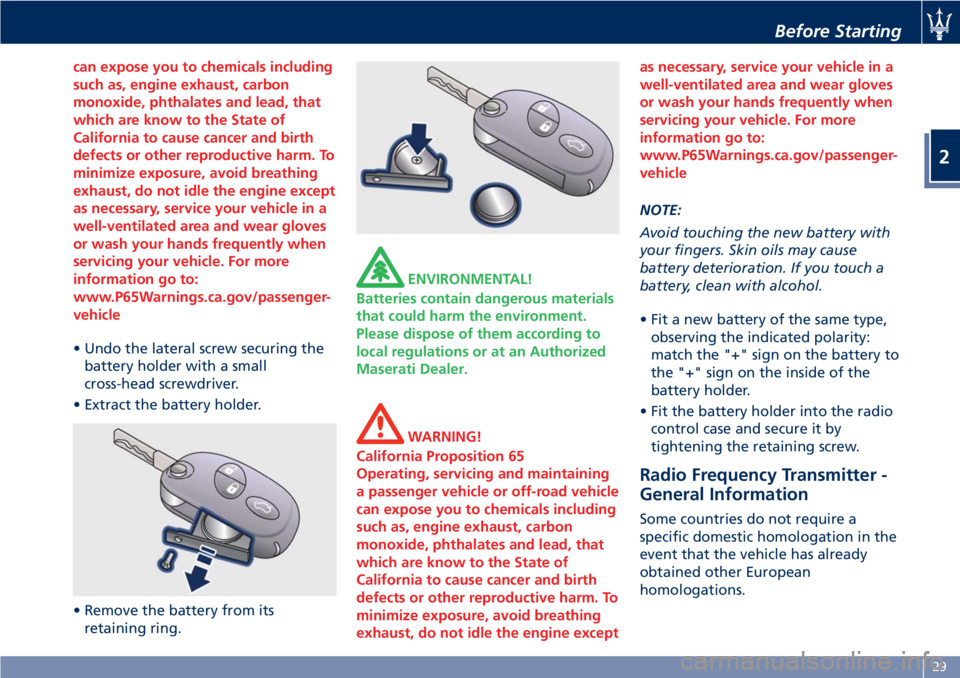
can expose you to chemicals including
such as, engine exhaust, carbon
monoxide, phthalates and lead, that
which are know to the State of
California to cause cancer and birth
defects or other reproductive harm. To
minimize exposure, avoid breathing
exhaust, do not idle the engine except
as necessary, service your vehicle in a
well-ventilated area and wear gloves
or wash your hands frequently when
servicing your vehicle. For more
information go to:
www.P65Warnings.ca.gov/passenger-
vehicle
• Undo the lateral screw securing the
battery holder with a small
cross-head screwdriver.
• Extract the battery holder.
• Remove the battery from its
retaining ring.
ENVIRONMENTAL!
Batteries contain dangerous materials
that could harm the environment.
Please dispose of them according to
local regulations or at an Authorized
Maserati Dealer.
WARNING!
California Proposition 65
Operating, servicing and maintaining
a passenger vehicle or off-road vehicle
can expose you to chemicals including
such as, engine exhaust, carbon
monoxide, phthalates and lead, that
which are know to the State of
California to cause cancer and birth
defects or other reproductive harm. To
minimize exposure, avoid breathing
exhaust, do not idle the engine exceptas necessary, service your vehicle in a
well-ventilated area and wear gloves
or wash your hands frequently when
servicing your vehicle. For more
information go to:
www.P65Warnings.ca.gov/passenger-
vehicle
NOTE:
Avoid touching the new battery with
your fingers. Skin oils may cause
battery deterioration. If you touch a
battery, clean with alcohol.
• Fit a new battery of the same type,
observing the indicated polarity:
match the "+" sign on the battery to
the "+" sign on the inside of the
battery holder.
• Fit the battery holder into the radio
control case and secure it by
tightening the retaining screw.
Radio Frequency Transmitter -
General Information
Some countries do not require a
specific domestic homologation in the
event that the vehicle has already
obtained other European
homologations.
Before Starting
2
29
Page 177 of 286
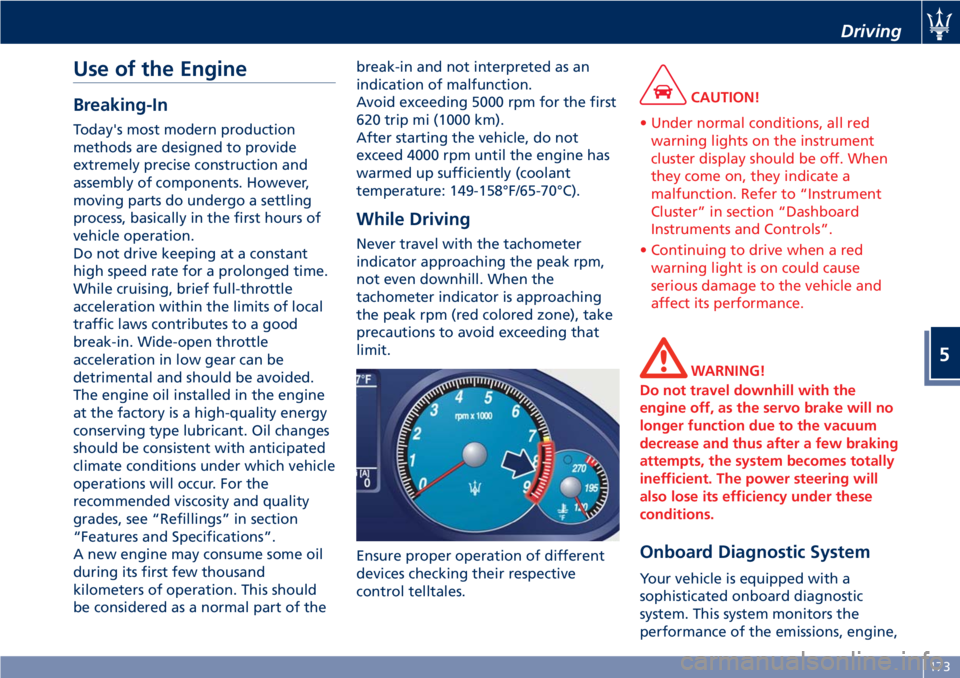
Use of the Engine
Breaking-In
Today's most modern production
methods are designed to provide
extremely precise construction and
assembly of components. However,
moving parts do undergo a settling
process, basically in the first hours of
vehicle operation.
Do not drive keeping at a constant
high speed rate for a prolonged time.
While cruising, brief full-throttle
acceleration within the limits of local
traffic laws contributes to a good
break-in. Wide-open throttle
acceleration in low gear can be
detrimental and should be avoided.
The engine oil installed in the engine
at the factory is a high-quality energy
conserving type lubricant. Oil changes
should be consistent with anticipated
climate conditions under which vehicle
operations will occur. For the
recommended viscosity and quality
grades, see “Refillings” in section
“Features and Specifications”.
A new engine may consume some oil
during its first few thousand
kilometers of operation. This should
be considered as a normal part of thebreak-in and not interpreted as an
indication of malfunction.
Avoid exceeding 5000 rpm for the first
620 trip mi (1000 km).
After starting the vehicle, do not
exceed 4000 rpm until the engine has
warmed up sufficiently (coolant
temperature: 149-158°F/65-70°C).
While Driving
Never travel with the tachometer
indicator approaching the peak rpm,
not even downhill. When the
tachometer indicator is approaching
the peak rpm (red colored zone), take
precautions to avoid exceeding that
limit.
Ensure proper operation of different
devices checking their respective
control telltales.
CAUTION!
• Under normal conditions, all red
warning lights on the instrument
cluster display should be off. When
they come on, they indicate a
malfunction. Refer to “Instrument
Cluster” in section “Dashboard
Instruments and Controls”.
• Continuing to drive when a red
warning light is on could cause
serious damage to the vehicle and
affect its performance.
WARNING!
Do not travel downhill with the
engine off, as the servo brake will no
longer function due to the vacuum
decrease and thus after a few braking
attempts, the system becomes totally
inefficient. The power steering will
also lose its efficiency under these
conditions.
Onboard Diagnostic System
Your vehicle is equipped with a
sophisticated onboard diagnostic
system. This system monitors the
performance of the emissions, engine,
Driving
5
173
Page 236 of 286
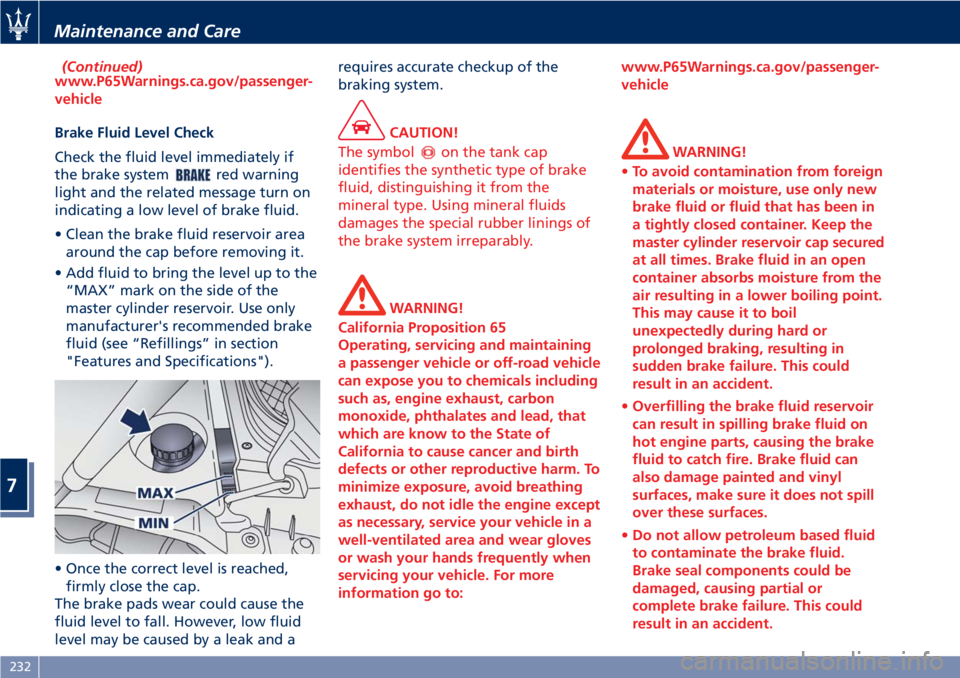
(Continued)
www.P65Warnings.ca.gov/passenger-
vehicle
Brake Fluid Level Check
Check the fluid level immediately if
the brake system
red warning
light and the related message turn on
indicating a low level of brake fluid.
• Clean the brake fluid reservoir area
around the cap before removing it.
• Add fluid to bring the level up to the
“MAX” mark on the side of the
master cylinder reservoir. Use only
manufacturer's recommended brake
fluid (see “Refillings” in section
"Features and Specifications").
• Once the correct level is reached,
firmly close the cap.
The brake pads wear could cause the
fluid level to fall. However, low fluid
level may be caused by a leak and arequires accurate checkup of the
braking system.
CAUTION!
The symbol
on the tank cap
identifies the synthetic type of brake
fluid, distinguishing it from the
mineral type. Using mineral fluids
damages the special rubber linings of
the brake system irreparably.
WARNING!
California Proposition 65
Operating, servicing and maintaining
a passenger vehicle or off-road vehicle
can expose you to chemicals including
such as, engine exhaust, carbon
monoxide, phthalates and lead, that
which are know to the State of
California to cause cancer and birth
defects or other reproductive harm. To
minimize exposure, avoid breathing
exhaust, do not idle the engine except
as necessary, service your vehicle in a
well-ventilated area and wear gloves
or wash your hands frequently when
servicing your vehicle. For more
information go to:www.P65Warnings.ca.gov/passenger-
vehicle
WARNING!
•To avoid contamination from foreign
materials or moisture, use only new
brake fluid or fluid that has been in
a tightly closed container. Keep the
master cylinder reservoir cap secured
at all times. Brake fluid in an open
container absorbs moisture from the
air resulting in a lower boiling point.
This may cause it to boil
unexpectedly during hard or
prolonged braking, resulting in
sudden brake failure. This could
result in an accident.
•Overfilling the brake fluid reservoir
can result in spilling brake fluid on
hot engine parts, causing the brake
fluid to catch fire. Brake fluid can
also damage painted and vinyl
surfaces, make sure it does not spill
over these surfaces.
•Do not allow petroleum based fluid
to contaminate the brake fluid.
Brake seal components could be
damaged, causing partial or
complete brake failure. This could
result in an accident.
Maintenance and Care
7
232
Page 259 of 286
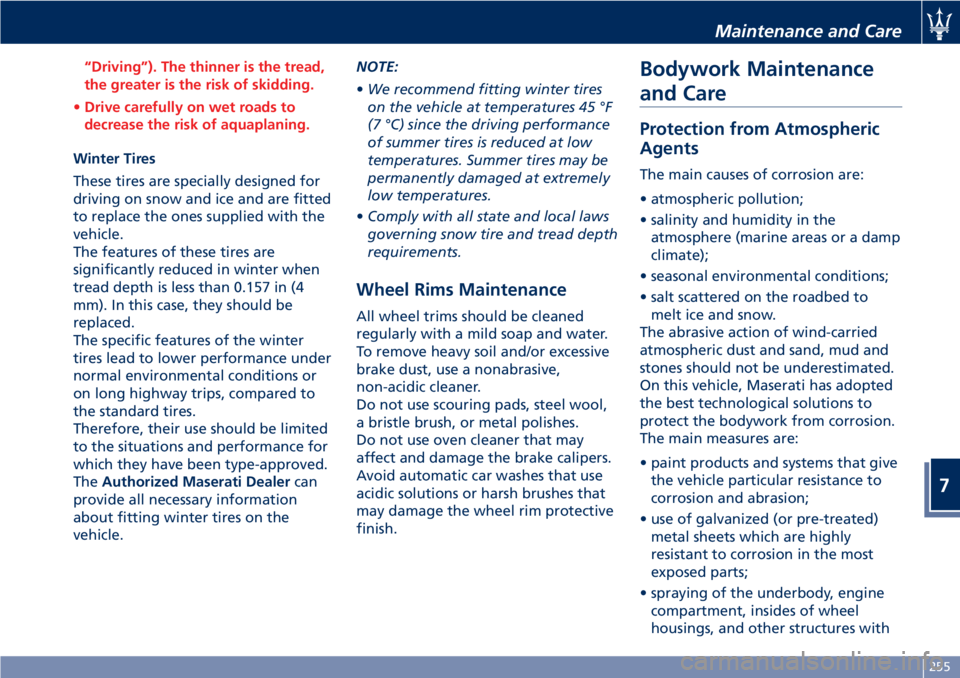
“Driving”). The thinner is the tread,
the greater is the risk of skidding.
•Drive carefully on wet roads to
decrease the risk of aquaplaning.
Winter Tires
These tires are specially designed for
driving on snow and ice and are fitted
to replace the ones supplied with the
vehicle.
The features of these tires are
significantly reduced in winter when
tread depth is less than 0.157 in (4
mm). In this case, they should be
replaced.
The specific features of the winter
tires lead to lower performance under
normal environmental conditions or
on long highway trips, compared to
the standard tires.
Therefore, their use should be limited
to the situations and performance for
which they have been type-approved.
TheAuthorized Maserati Dealercan
provide all necessary information
about fitting winter tires on the
vehicle.NOTE:
•We recommend fitting winter tires
on the vehicle at temperatures 45 °F
(7 °C) since the driving performance
of summer tires is reduced at low
temperatures. Summer tires may be
permanently damaged at extremely
low temperatures.
•Comply with all state and local laws
governing snow tire and tread depth
requirements.
Wheel Rims Maintenance
All wheel trims should be cleaned
regularly with a mild soap and water.
To remove heavy soil and/or excessive
brake dust, use a nonabrasive,
non-acidic cleaner.
Do not use scouring pads, steel wool,
a bristle brush, or metal polishes.
Do not use oven cleaner that may
affect and damage the brake calipers.
Avoid automatic car washes that use
acidic solutions or harsh brushes that
may damage the wheel rim protective
finish.
Bodywork Maintenance
and Care
Protection from Atmospheric
Agents
The main causes of corrosion are:
• atmospheric pollution;
• salinity and humidity in the
atmosphere (marine areas or a damp
climate);
• seasonal environmental conditions;
• salt scattered on the roadbed to
melt ice and snow.
The abrasive action of wind-carried
atmospheric dust and sand, mud and
stones should not be underestimated.
On this vehicle, Maserati has adopted
the best technological solutions to
protect the bodywork from corrosion.
The main measures are:
• paint products and systems that give
the vehicle particular resistance to
corrosion and abrasion;
• use of galvanized (or pre-treated)
metal sheets which are highly
resistant to corrosion in the most
exposed parts;
• spraying of the underbody, engine
compartment, insides of wheel
housings, and other structures with
Maintenance and Care
7
255
Page 271 of 286
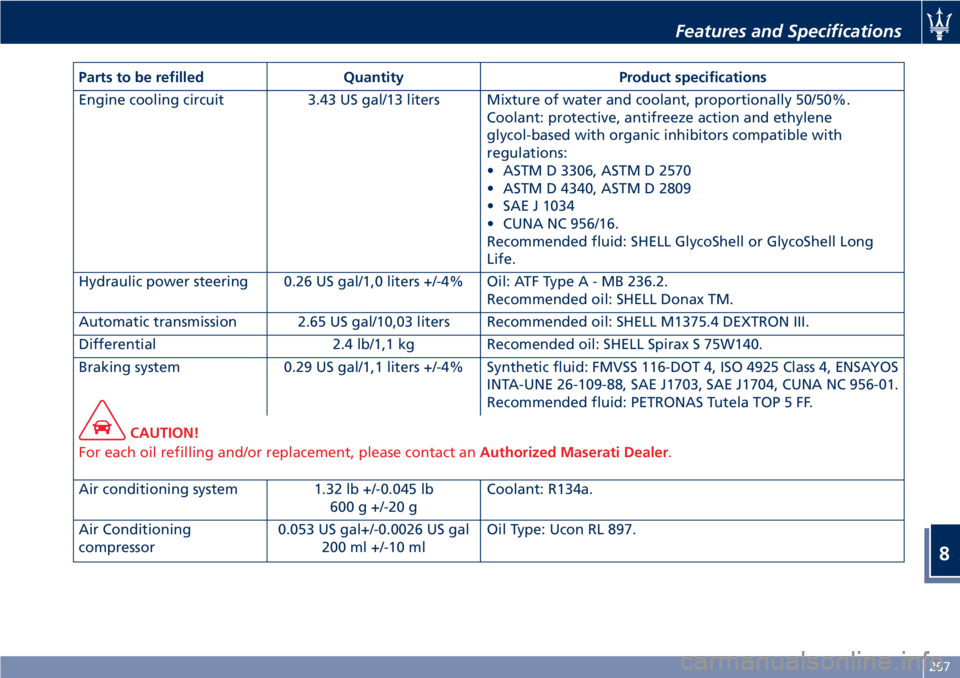
Parts to be refilled Quantity Product specifications
Engine cooling circuit 3.43 US gal/13 liters Mixture of water and coolant, proportionally 50/50%.
Coolant: protective, antifreeze action and ethylene
glycol-based with organic inhibitors compatible with
regulations:
• ASTM D 3306, ASTM D 2570
• ASTM D 4340, ASTM D 2809
• SAE J 1034
• CUNA NC 956/16.
Recommended fluid: SHELL GlycoShell or GlycoShell Long
Life.
Hydraulic power steering 0.26 US gal/1,0 liters +/-4% Oil: ATF TypeA-MB236.2.
Recommended oil: SHELL Donax TM.
Automatic transmission 2.65 US gal/10,03 liters Recommended oil: SHELL M1375.4 DEXTRON III.
Differential 2.4 lb/1,1 kg Recomended oil: SHELL Spirax S 75W140.
Braking system 0.29 US gal/1,1 liters +/-4% Synthetic fluid: FMVSS 116-DOT 4, ISO 4925 Class 4, ENSAYOS
INTA-UNE 26-109-88, SAE J1703, SAE J1704, CUNA NC 956-01.
Recommended fluid: PETRONAS Tutela TOP 5 FF.
CAUTION!
For each oil refilling and/or replacement, please contact anAuthorized Maserati Dealer.
Air conditioning system 1.32 lb +/-0.045 lb
600 g +/-20 gCoolant: R134a.
Air Conditioning
compressor0.053 US gal+/-0.0026 US gal
200 ml +/-10 mlOil Type: Ucon RL 897.
Features and Specifications
8
267